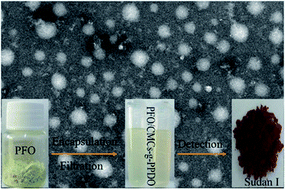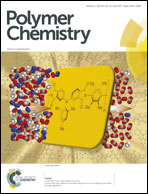Self-assembled conjugated polymer/carboxymethyl chitosan grafted poly(p-dioxanone) nanomicelles and their use in functionalized indicator paper for fast and visual detection of a banned food dye†
Abstract
A novel sensing colloidal nanoprobe and indicator paper based on fluorescent carboxymethyl chitosan grafted poly(p-dioxanone) (CMCs-g-PPDO) copolymer nanomicelles which encapsulate hydrophobic conjugated polymer-poly(9,9-dioctylfluorene) (PFO) were developed for the fast and sensitive determination of banned food dye Sudan I. The PFO/CMCs-g-PPDO colloidal solution can selectively detect Sudan I in aqueous media among commonly appearing natural pigments: β-carotene, Monascorubrin and Lycopene. The sensing constant (Ksv) for the PFO/CMCs-g-PPDO aqueous solution toward Sudan I was 1.74 × 107 M−1, which was over 400 times larger than that of single PFO in toluene solution, due to the maximized interaction between the sensing material and the analyte within the chitosan-based nanomicelles. The fluorescent indicator paper functionalized with PFO/CMCs-g-PPDO also showed outstanding selectivity for Sudan I. By using this flexible and portable indicator paper, Sudan I dye could be immediately and visually distinguished from natural pigments. This material could be used for real-time and on-site food safety testing.


 Please wait while we load your content...
Please wait while we load your content...